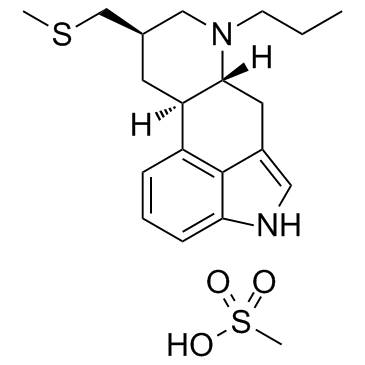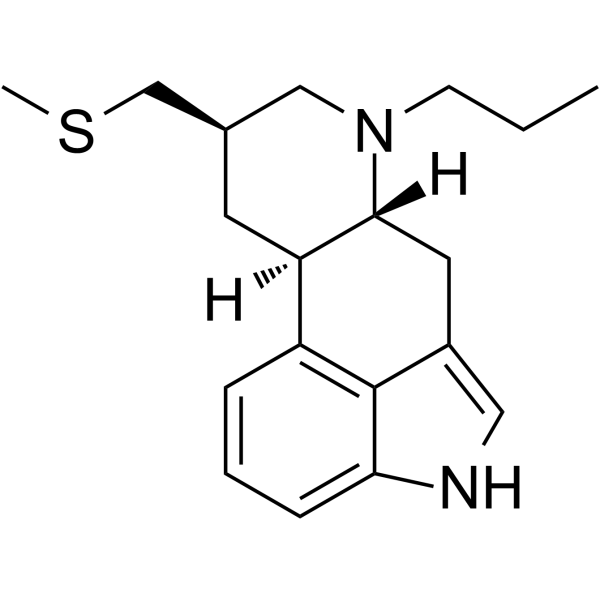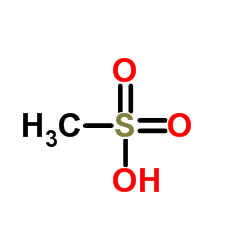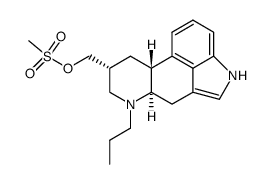66104-23-2
| 中文名 | 甲磺酸培高利特 |
|---|---|
| 英文名 | pergolide mesylate |
| 中文别名 |
8Β-[(甲硫基)甲基]-6-丙基麦角灵甲基磺酸盐
苯磺酸贝他斯汀 |
| 英文别名 |
Pergolide methanesulfonate salt
Ergoline Pergolide mesilate (6aR,9R,10aR)-9-[(methylsulfanyl)methyl]-7-propyl-4,6,6a,7,8,9,10,10a-octahydroindolo[4,3-fg]quinoline methanesulfonate (6aR,9R,10aR)-9-(methylsulfanylmethyl)-7-propyl-6,6a,8,9,10,10a-hexahydro-4H-indolo[4,3-fg]quinoline,methanesulfonic acid Celance Ergoline, 8-[(methylthio)methyl]-6-propyl-, (8β)-, methanesulfonate (1:1) (8β)-8-[(methylsulfanyl)methyl]-6-propylergoline methanesulfonate MFCD00153859 UNII-55B9HQY616 Permax 8-b-((Methylthio)methyl)-6-propylergoline Methanesulfonate Pergolide mesylate Methansulfonsäure--(6aR,9R,10aR)-9-[(methylsulfanyl)methyl]-7-propyl-4,6,6a,7,8,9,10,10a-octahydroindolo[4,3-fg]chinolin(1:1) (8β)-8-[(Methylsulfanyl)methyl]-6-propylergoline methanesulfonate (1:1) Pergolide mesylate salt 8b-((Methylthio)methyl)-6-propylergoline Monomethanesulfonate Pergolide methanesulfonate Pergolide (mesylate) |
| 描述 | Pergolide甲磺酸盐是有抗帕金森病特性的多巴胺受体激动剂。 |
|---|---|
| 相关类别 | |
| 参考文献 |
| 沸点 | 491.3ºC at 760 mmHg |
|---|---|
| 熔点 | 252-254°C |
| 分子式 | C20H30N2O3S2 |
| 分子量 | 410.594 |
| 闪点 | 250.9ºC |
| 精确质量 | 410.169769 |
| PSA | 107.08000 |
| LogP | 4.79380 |
| 外观性状 | 白色至灰白色固体 |
| 储存条件 | 存放在密封容器内,并放在阴凉,干燥处。储存的地方必须远离氧化剂。-20ºC保存。 |
| 稳定性 | 远离氧化物。 |
| 计算化学 | 1.疏水参数计算参考值(XlogP):无 2.氢键供体数量:2 3.氢键受体数量:5 4.可旋转化学键数量:4 5.互变异构体数量:无 6.拓扑分子极性表面积107 7.重原子数量:27 8.表面电荷:0 9.复杂度:480 10.同位素原子数量:0 11.确定原子立构中心数量:3 12.不确定原子立构中心数量:0 13.确定化学键立构中心数量:0 14.不确定化学键立构中心数量:0 15.共价键单元数量:2 |
| 更多 | 1. 性状:固体。 2. 密度(g/mL,25/4℃):未确定 3. 相对蒸汽密度(g/mL,空气=1):未确定 4. 熔点(ºC):252-254 5. 沸点(ºC,常压):未确定 6. 沸点(ºC,5.2kPa):未确定 7. 折射率:未确定 8. 闪点(ºC):未确定 9. 比旋光度(º):未确定 10. 自燃点或引燃温度(ºC):未确定 11. 蒸气压(kPa,25ºC):未确定 12. 饱和蒸气压(kPa,60ºC):未确定 13. 燃烧热(KJ/mol):未确定 14. 临界温度(ºC):未确定 15. 临界压力(KPa):未确定 16. 油水(辛醇/水)分配系数的对数值:未确定 17. 爆炸上限(%,V/V):未确定 18. 爆炸下限(%,V/V):未确定 19. 溶解性:未确定 。 |
|
Section 1. Chemical Product and Company Identification Pergolide Mesylate Common Name/ Trade Name Pergolide Mesylate Section 4. First Aid Measures Check for and remove any contact lenses. In case of contact, immediately flush eyes with plenty of water for at least
Eye Contact 15 minutes. Cold water may be used. Get medical attention. In case of contact, immediately flush skin with plenty of water for at least 15 minutes while removing contaminated Skin Contact clothing and shoes. Cover the irritated skin with an emollient. Cold water may be used.Wash clothing before reuse. Thoroughly clean shoes before reuse. Get medical attention immediately. Serious Skin ContactWash with a disinfectant soap and cover the contaminated skin with an anti-bacterial cream. Seek immediate medical attention. InhalationIf inhaled, remove to fresh air. If not breathing, give artificial respiration. If breathing is difficult, give oxygen. Get medical attention immediately. Serious InhalationEvacuate the victim to a safe area as soon as possible. Loosen tight clothing such as a collar, tie, belt or waistband. WARNING: It may be hazardous to the person providing aid to give mouth-to-mouth resuscitation when the inhaled material is toxic, infectious or corrosive. Seek immediate medical attention. If swallowed, do not induce vomiting unless directed to do so by medical personnel. Never give anything by mouth to Ingestion an unconscious person. Loosen tight clothing such as a collar, tie, belt or waistband. Get medical attention immediately. Not available. Serious Ingestion Section 5. Fire and Explosion Data Flammability of the Product May be combustible at high temperature. Auto-Ignition Temperature Not available. Not available. Flash Points Not available. Flammable Limits These products are carbon oxides (CO, CO2), nitrogen oxides (NO, NO2...), sulfur oxides (SO2, SO3...). Products of Combustion Fire Hazards in Presence of Slightly flammable to flammable in presence of heat. Non-flammable in presence of shocks. Various Substances Risks of explosion of the product in presence of mechanical impact: Not available. Explosion Hazards in Slightly explosive in presence of open flames and sparks. Presence of Various Substances SMALL FIRE: Use DRY chemical powder. Fire Fighting Media LARGE FIRE: Use water spray, fog or foam. Do not use water jet. and Instructions As with most organic solids, fire is possible at elevated temperatures Special Remarks on Fire Hazards Fine dust dispersed in air in sufficient concentrations, and in the presences of an ignition source is a potential dust Special Remarks on explosion hazard. Explosion Hazards Section 6. Accidental Release Measures Use appropriate tools to put the spilled solid in a convenient waste disposal container. Small Spill Poisonous solid. Large Spill Stop leak if without risk. Do not get water inside container. Do not touch spilled material. Use water spray to reduce for assistance on disposal. Pergolide Mesylate Section 7. Handling and Storage Keep away from heat. Keep away from sources of ignition. Ground all equipment containing material. Do not Precautions ingest. Do not breathe dust. Wear suitable protective clothing. In case of insufficient ventilation, wear suitable respiratory equipment. If ingested, seek medical advice immediately and show the container or the label. Avoid contact with skin and eyes. Keep container tightly closed. Keep container in a cool, well-ventilated area. Sensitive to light. Store in Storage light-resistant containers. Section 8. Exposure Controls/Personal Protection Use process enclosures, local exhaust ventilation, or other engineering controls to keep airborne levels below Engineering Controls recommended exposure limits. If user operations generate dust, fume or mist, use ventilation to keep exposure to airborne contaminants below the exposure limit. Personal ProtectionSplash goggles. Lab coat. Dust respirator. Be sure to use an approved/certified respirator or equivalent. Gloves. Personal Protection in Case Splash goggles. Full suit. Dust respirator. Boots. Gloves. A self contained breathing apparatus should be used to avoid inhalation of the product. Suggested protective clothing might not be sufficient; consult a specialist BEFORE of a Large Spill handling this product. Not available. Exposure Limits Section 9. Physical and Chemical Properties Solid.Perceptible odor (Slight.) Physical state andO dor appearance Not available. Taste 410.64 g/mole Molecular Weight White. Color Not available. pH (1% soln/water) Not available. Boiling Point Decomposition temperature: 225°C (437°F) Melting Point Not available. Critical Temperature Not available. Specific Gravity Not applicable. Vapor Pressure Not available. Vapor Density Not available. Volatility Not available. Odor Threshold Not available. Water/Oil Dist. Coeff. Not available. Ionicity (in Water) See solubility in water. Dispersion Properties Very slightly soluble in cold water. Solubility Soluble in most organic substances Pergolide Mesylate Section 10. Stability and Reactivity Data The product is stable. Stability Not available. Instability Temperature Conditions of Instability Excess heat, dust generation, incompatible materials Incompatibility with various Not available. substances Not available. Corrosivity Not available. Special Remarks on Reactivity Not available. Special Remarks on Corrosivity Will not occur. Polymerization Section 11. Toxicological Information Inhalation. Ingestion. Routes of Entry Toxicity to AnimalsAcute oral toxicity (LD50): 8.4 mg/kg [Rat]. Chronic Effects on Humans May cause damage to the following organs: cardiovascular system, central nervous system (CNS). Very hazardous in case of ingestion, . Other Toxic Effects on HumansHazardous in case of skin contact (irritant), of inhalation (lung irritant). Not available. Special Remarks on Toxicity to Animals May cause adverse reproductive effects and birth defects (teratogenic) Special Remarks on Chronic Effects on Humans Acute Potential Health Effects: Special Remarks on other Skin: Causes skin irritation. Toxic Effects on Humans Eyes: Causes eye irritation. Inhalation: Harmful if inhaled. Causes respiratory tract irritation. Ingestion: May be fatal if swallowed. Causes gastrointestinal tract irritation with nausea, and vomiting. May also affect behavior/central nervous system (temor, excitement, hallucinations, aggression, convulsions), metabolsim, and respiratory system (respiratory stimulation), cardiovascular system, eyes (ptosis, pupillary dilation). Chronic Potential Health Effects: Ingestion: Repeated or prolonged ingestion may also affect behavior/central nervous system), blood (red and white blood cell count), metabolism (weight loss), prostate, ovaries (changes in prostate and ovarian weight). Section 12. Ecological Information Not available. Ecotoxicity Not available. BOD5 and COD Products of Biodegradation Possibly hazardous short term degradation products are not likely. However, long term degradation products may arise. The products of degradation are less toxic than the product itself. Toxicity of the Products of Biodegradation Not available. Special Remarks on the Products of Biodegradation Pergolide Mesylate Section 13. Disposal Considerations Waste must be disposed of in accordance with federal, state and local environmental control Waste Disposal regulations. Section 14. Transport Information CLASS 6.1: Poisonous material. DO T Cl assi fi cati on UNNA: 2811 : Toxic Solid, Organic, n.o.s. (Pergolide Mesylate) PG: II Identification Not available. Special Provisions for Transport DO T (Pi ctograms) Section 15. Other Regulatory Information and Pictograms No products were found. Federal and State Regulations California prop. 65: This product contains the following ingredients for which the State of California has found to California cause cancer which would require a warning under the statute: No products were found. Proposition 65 Warnings California prop. 65: This product contains the following ingredients for which the State of California has found to cause birth defects which would require a warning under the statute: No products were found. Other RegulationsOSHA: Hazardous by definition of Hazard Communication Standard (29 CFR 1910.1200). EINECS: This product is not on the European Inventory of Existing Commercial Chemical Substances. Canada: Not listed on Canadian Domestic Substance List (DSL) or Canadian Non- Domestic Substance List (NDSL). China: Not listed on National Inventory. Japan: Not listed on National Inventory (ENCS). Korea: Not listed on National Inventory (KECI). Philippines: Not listed on National Inventory (PICCS). Australia: Not listed on AICS. WHMIS (Canada) It has not been classified by the Service du repertoire toxicologique. However, it may fall Other Classifications into the CLASS D-1A: Material causing immediate and serious toxic effects (VERY TOXIC). R26/27/28- Very toxic by inhalation, inS22- Do not breathe dust. DSCL (EEC) contact with skin and if swallowed.S26- In case of contact with eyes, rinse R36/37/38- Irritating to eyes, respiratoryimmediately with plenty of water and seek system and skin.medical advice. R40- Limited evidence of aS36/37/39- Wear suitable protective clothing, carcinogenic effect.gloves and eye/face protection. R60- May impair fertility.S38- In case of insufficient ventilation, wear R63- Possible risk of harm to the unbornsuitable respiratory equipment. child.S45- In case of accident or if you feel unwell, seek medical advice immediately (show the label where possible). HMIS (U.S.A.)Health Hazard3 National Fire Protection 1 Flammability 1 Association (U.S.A.) Fire Hazard 3 0 Reactivity Health Reactivity 0 Specific hazard Personal Protection E WHMIS (Canada) (Pictograms) Pergolide Mesylate DSCL (Europe) (Pictograms) TDG(Canada) (Pictograms) ADR (Europe) (Pictograms) Protective Equipment Gloves. Lab coat. Dust respirator. Be sure to use an approved/certified respirator or equivalent. SECTION 16 - ADDITIONAL INFORMATION N/A |
CHEMICAL IDENTIFICATION
HEALTH HAZARD DATAACUTE TOXICITY DATA
|
| 符号 |

GHS06 |
|---|---|
| 信号词 | Danger |
| 危害声明 | H300 |
| 警示性声明 | Missing Phrase - N15.00950417 |
| 个人防护装备 | Eyeshields;Faceshields;full-face particle respirator type N100 (US);Gloves;respirator cartridge type N100 (US);type P1 (EN143) respirator filter;type P3 (EN 143) respirator cartridges |
| 危害码 (欧洲) | T+: Very toxic; |
| 风险声明 (欧洲) | R28 |
| 安全声明 (欧洲) | S28-S36/37-S45 |
| 危险品运输编码 | UN 1544 |
| RTECS号 | KE6345000 |
| 上游产品 5 | |
|---|---|
| 下游产品 0 | |







